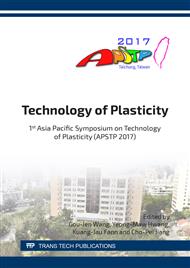p.193
p.199
p.205
p.211
p.217
p.223
p.230
p.236
p.244
Microstructure and Texture Evolution of 2024 Aluminum Alloy Sheet under Different Loading Conditions
Abstract:
To study microstructure and texture evolution of 2024 aluminum alloy sheet under different loading conditions, thermal tensile and compression experiments of 2024 aluminum alloy rolled sheets were carried out at temperatures ranging from 300 °C to 450 °C and under strain rates ranging from 0.001 s-1 to 0.1 s-1. During tensile deformation, the HABs of original grains are directly elongated until abruption. DRX process occurs during compression. Dislocations appear during deformation, migrate and accumulate into LABs, and then rotate into HABs to form new grain.The three-dimensional orientation distribution functions (ODFs) in different stress states were measured, with related texture types and distribution laws compared. According to ODFs with a constant φ2, the deformation texture of {011} <100>Goss texture is gradually strengthened during thermal tension at high temperature and low strain rate (450°C/0.001s-1). The deformation texture of {011} <100>Goss texture is weakened with the strain increasing. Furthermore, the increase of deformation temperature or the decrease of strain rate slows down the weakening process of {011} <100> Goss texture, which is attributed to the recrystallization behavior during tensile deformation. Besides, since the recrystallization process proceeds more completely during hot compression, it produces a quasi-random texture.
Info:
Periodical:
Pages:
236-243
Citation:
Online since:
April 2018
Authors:
Keywords:
Price:
Сopyright:
© 2018 Trans Tech Publications Ltd. All Rights Reserved
Share:
Citation:


